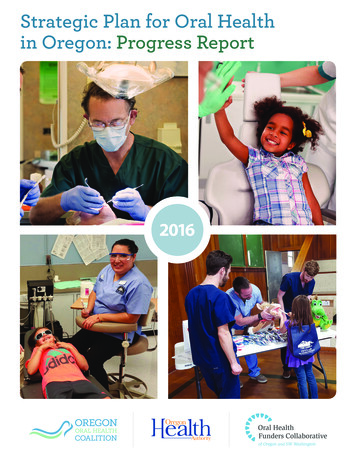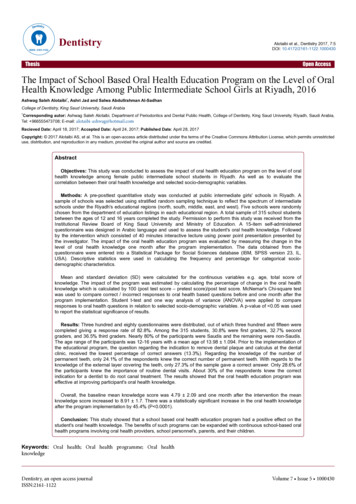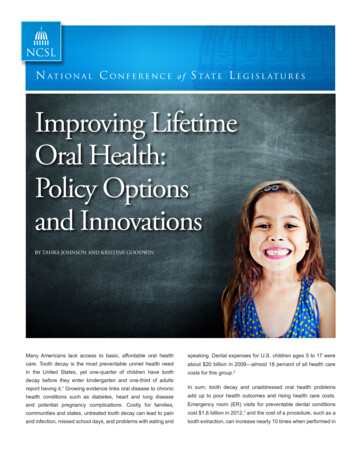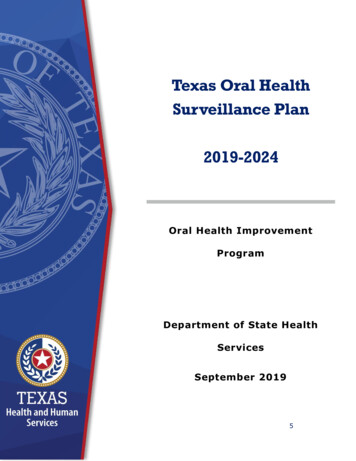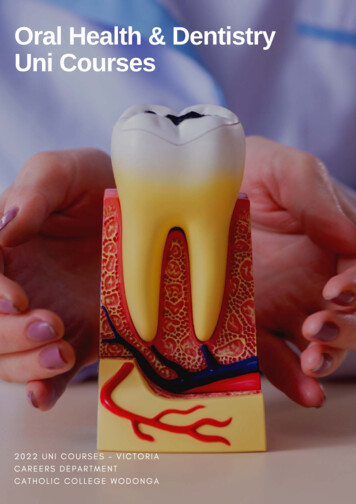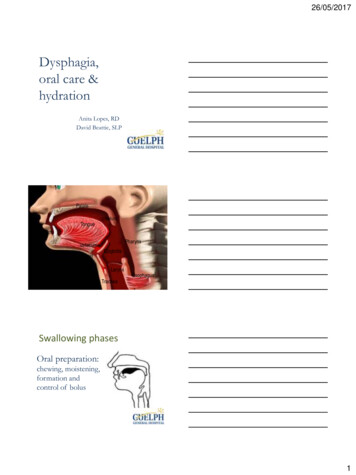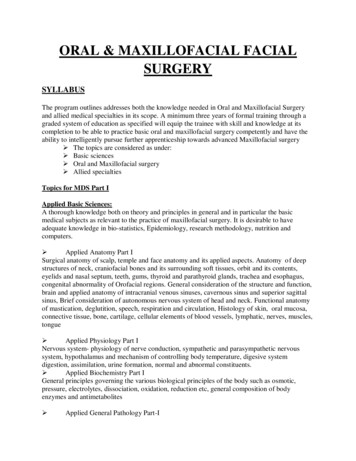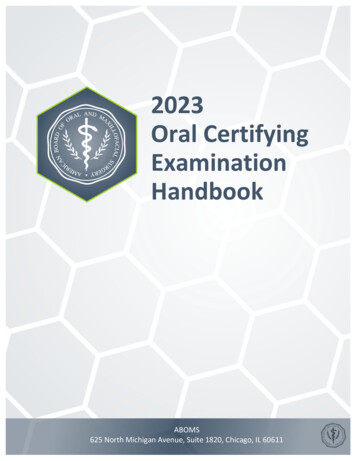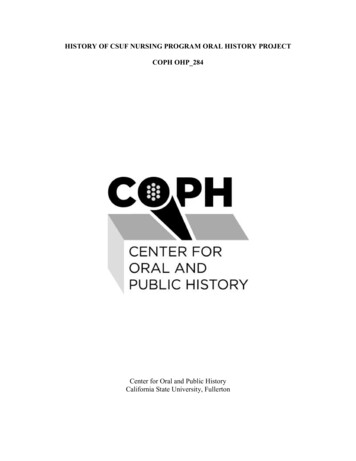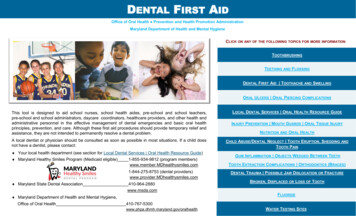
Transcription
DENTAL FIRST AIDOffice of Oral Health Prevention and Health Promotion AdministrationMaryland Department of Health and Mental HygieneCLICK ON ANY OF THE FOLLOWING TOPICS FOR MORE INFORMATIONTOOTHBRUSHINGTEETHING AND FLOSSINGDENTAL FIRST AID TOOTHACHE AND SWELLINGORAL ULCERS ORAL PIERCING COMPLICATIONSLOCAL DENTAL SERVICES ORAL HEALTH RESOURCE GUIDEThis tool is designed to aid school nurses, school health aides, pre-school and school teachers,pre-school and school administrators, daycare coordinators, healthcare providers, and other health andadministrative personnel in the effective management of dental emergencies and basic oral healthprinciples, prevention, and care. Although these first aid procedures should provide temporary relief andassistance, they are not intended to permanently resolve a dental problem.INJURY PREVENTION MOUTH GUARDS ORAL TISSUE INJURYA local dentist or physician should be consulted as soon as possible in most situations. If a child doesnot have a dentist, please contact:CHILD ABUSE/DENTAL NEGLECT TOOTH ERUPTION, SHEDDING ANDTOOTH PAIN Your local health department (see section for Local Dental Services Oral Health Resource Guide) Maryland Healthy Smiles Program (Medicaid eligible)1-855-934-9812 (program 53 (dental providers)www.provider.MDhealthysmiles.com Maryland State Dental Association410-964-2880www.msda.com Maryland Department of Health and Mental Hygiene,Office of Oral HealthNUTRITION AND ORAL HEALTHGUM INFLAMMATION OBJECTS WEDGED BETWEEN TEETHTOOTH EXTRACTION COMPLICATIONS ORTHODONTICS (BRACES)DENTAL TRAUMA POSSIBLE JAW DISLOCATION OR FRACTUREBROKEN, DISPLACED OR LOSS OF v/oralhealthWATER TESTING SITES
Proper toothbrushing is not difficult. Just follow these steps:Place the toothbrush against the gum line at a 45-degree angle. Use asmall circular motion to brush your teeth.Brush back and forth on the chewing surfaces of your teeth holding thebrush flat.TOOTHBRUSHINGPlaque contains a sticky layer of germs which canlead to tooth decay and gum disease. Brush withtoothpaste containing fluoride for at least twominutes, twice a day (after breakfast and beforebed). This keeps the teeth and gums healthy.Brush the back of your teeth!Brush your tongue! This will freshen your breath and remove germs.Brush for at least two minutes, two times a day.Be sure to brush at bedtime to remove germs that can cause decay whileyou are sleeping.2 minutes Always use a soft-bristle toothbrush andalways use toothpaste with fluoride. Usethe correct amount of toothpaste accordingto age.(see chart) Replace your toothbrush every 3 months. 2 times a day4 a Healthy SmileWithBrushing Tips:FluorideToothpaste Never sharegerms.toothbrushes,it spreads Children at high risk for tooth decay shoulduse toothpaste that has fluoride as soon asthe first tooth appears.Under Age 3: Slightsmear about the size ofa grain of riceAges 3 - 6:Pea-sized amount(Toothbrush images courtesy ofDr.Norman Tinanoff, University of MarylandSchool of Dentistry) Children younger than age 8 needsupervision to make sure they do not usetoo much toothpaste and that they brushtheir teeth thoroughly.Spit, do not rinseafter brushing.
TEETHINGBabies begin teething around 5 months of age. Local discomfort iscommon with tooth eruption and can be associated with cold, fever ordiarrhea.Flossing is as easy as brushing once you know how.Follow these steps:Strategies to ease the pain and discomfort of teethingKeep it safe: Make sure liquid-filled teething toys are made of durable materials that thebaby cannot chew a hole into. Use plastic teething toys that do not contain bisphenol A(BPA). Find teething toys that do not have loose pieces that could break off in baby’smouth and cause choking.Cool it: Give the baby a refrigerated clean wet washcloth, spoon, pacifier, or teethingring to chew on. Cold helps the pain of sore gums. Teething rings should NOT be put in thefreezer.Freeze it: Unlike teething rings, certain frozen foods such as sliced peaches, canhelp ease teething pain.Massage it: Gently rub the baby’s gums with a clean finger for 2 minutes. Manybabies find the pressure soothing.Don’t use it: Oral health and medical providers do not recommend using teethinggels and liquids on babies’ gums.FLOSSINGFlossing removes plaque between teeth and above and below the gumline - areas a toothbrush cannot reach.By combining brushing with toothpaste that contains fluoride andflossing at the same time everyday (and with the appropriate diet), youcan thoroughly prevent the germ-containing plaque from causingcavities and gum disease.Wrap about 18 inches of floss around the middlefingers.Slide the floss between the teeth. (Do not snapthe floss into the gums but guide the floss gentlyjust below the gumline).As the floss reaches the gum line, make aC-shape around the tooth until you feel pressureagainst your tooth.Gently scrape the tooth surface with the floss.Move the floss as it becomes soiled and repeatthe process for each tooth. Floss every day.If assisting a child to floss, you should weargloves (non-latex).Children under the age of 8 should never floss without an adult’s help. A dentist or dental hygienist can show you how to floss your child’s teeth.
DENTAL FIRST AID SUPPLIESTOOTHACHE AND SWELLINGThe following should be present in your first aid kit for use in dentalemergencies:The following steps should be taken for a child with suspectedtoothache or facial swelling:Disposable non-latex gloves (should be worn atall times) Clean the area around the sore tooth thoroughly by rinsingMask (to be worn when blood may splatter) Check the child’s temperature and observe for respiratoryEyewear (to be worn when blood may splatter)Cotton swabsSterile gauze squares 2” x 2” or padsthe mouth with warm salt water.distress. Administer appropriate over-the-counter pain medication ifneeded.ToothbrushesDental flossDO NOT PLACE ASPIRIN ON THE GUM OR ACHING TOOTH!Ice pack or wet frozen washclothSaline or salt waterFlashlightTongue blade or dental mouth mirrorMedications cannot be used in most schools without a written approved protocol specific toeach drug and signed by a physician or dentist and written permission from a parent orcaregiver.When examining the mouth andsurrounding structures,ALWAYS wash your hands (before andafter) and ALWAYS wear non-latexgloves! If the child’s face is swollen, apply a cold compress or ice. Alternate 10 minuteson and 5 minutes off. If the child has a localized abscess or gum boil (with or without pain), avoidheat. Follow-up with the child to check the outcome of the toothache or swelling 24hours after first contact with the child. Refer to a dentist as soon as possible.NOTE: Your local health department, the Maryland Office of Oral Health, or theMaryland State Dental Association can be contactedfor names of dentists who accept emergencypatients. In addition, area dental schools, hospitalswith dental emergency facilities and other communitydental clinics can be contacted for emergency care.(See Local Dental Services in this flip chart or gov/oralhealthforcontactinformation.)
ORAL ULCERSORAL PIERCING COMPLICATIONSThere are many potential complications from piercing in and around themouth. Most adolescents are unaware of the complications of intraoralpiercing.Oral ulcers can be the result of: Aphthous lesion/canker sore (on softer mouthtissues) Cold sore/fever blister or traumatic lesion (onharder mouth tissues)The following steps should be taken for ulcers: Always wear non-latex gloves when touchinglesions. Before and after inspecting lesions andremoving gloves, wash hands thoroughly. Observe the location, type and severity oflesions. Takethe child’s temperature. ation (if needed and possible). Tell the child to avoid spicy foods. Apply ice to the area to provide temporary relief.Oral ulcers can bea symptom of:Herpes virusMumpsGerman measlesPossible ComplicationsTooth fracture or injuryStud aspirationAllergic reactionNerve damageSpeech impedimentImpetigoChicken poxStreptococcal infectionStressOther diseases or disorders Contact the child’s parent or caregiver for referralto a physician or dentist if fever and/or lesions persist.Gingival (gum) recessionInfectionManagement of ComplicationsIf the adolescent presents with inflammationaround a piercing, refer the child to a dentist orphysician who should: Remove the jewelry; Perform local debridement; Start antibiotics; Provide close follow-up.Complication of oral infection may includesepsis and airway obstruction.Aphthous lesion/canker sorePhoto credit: .www.fitnesshealthpros.comCold sore/fever blisterPhoto credit:www.healthtap.comRadiographshows rootrecessionPhoto credit: WashingtonInterdisciplinary Children’s OralHealth Promotion (ICOHP)GumrecessionThe innersurface ofthe lip boltPhoto credit: WashingtonInterdisciplinary Children’s OralHealth Promotion (ICOHP)Reference: Smiles for Life, A National Oral Health Curriculum. Course 4:Acute Dental Problems “Oral Piercing Complications.”www.smilesforlifeoralhealth.org, 01/13/2015.
DENTAL SCHOOLSUniversity of Maryland Dental School, Baltimore, MDHoward University Dental School, Washington, DCPediatric Clinic:410-706-4213Pediatric Clinic:202-806-0307Adult Clinic:410-706-7101Adult Clinic:202-806-0007CLINICAL DENTAL PROGRAMS OPERATED BY LOCAL HEALTH DEPARTMENTS AND FEDERALLY QUALIFIED HEALTH CENTERSAllegany CountyAllegany County Health Dept.301-759-5030Anne Arundel CountyAnne Arundel County Health Dept.Annapolis Health Center410-222-7138N. County Health Service Center 410-222-6861Baltimore CityBaltimore City Health Dept.Druid Dental Clinic410-396-0840Eastern Dental Clinic443-984-3548Chase Brexton Dental Clinic410-837-2050Family Health Centers of Baltimore 410-354-2000Healthcare for the Homeless410-837-5533University of MD Rehabilitation &Orthopaedic Institute (formerly Kernan Hospital)Restorative Services Dental Clinic410-448-6290Cleft Palate Clinic410-448-2500Park West Health Center410-542-7800Total Health Care410-383-8300University of Maryland School of DentistryGeneral Dentistry (Pre-Doctoral clinic)410-706-7101Advanced General Dentistry (Post-Doctoral clinic)410-706-2940Urgent Care (Emergency) Dentistry410-706-2716Pediatric rsity of MD Medical SystemDept. of Oral and Maxillofacial Surgery410-706-6195Baltimore CountyBaltimore County Health Dept.410-887-2781Chase Brexton Randallstown Center410-496-6441Calvert CountyCalvert Community Dental Care410-535-8402Caroline CountyChoptank Community Health SystemFederalsburg Dental Center410-754-7583Goldsboro Family Dental Center 410-482-2224Carroll CountyAccess CarrollCarroll County Health Dept.410-871-1478410-876-4918Cecil CountyUniversity of MD School of Dentistry-Perryville410-706-4900West Cecil Health Center410-378-9696Charles CountyCharles County Health Dept.Health Partners, Inc.Harford CountyHarford County Health Dept.443-922-7670Howard CountyChase Brexton, Columbia410-884-7831Queen Anne’s Countyrefer to Caroline and Cecil County listingsSomerset CountyThree Lower Counties CommunityKent Countyrefer to Caroline and Cecil County listingsMontgomery CountyCommunity Clinic, Inc.240-720-0510Montgomery County Health Dept.Piccard Drive Health Center240-777-1875Fenton Street Dental Clinic240-777-3135Germantown Health Center240-777-3290Services, Inc. (TLC)St. Mary’s CountySt. Mary’s County Health Dept.refer to listings for Caroline CountyMetro Court Adult Dental Clinic 240-773-0304Washington CountyColesville Adult Dental Clinic301-384-9795Walnut Street Community CenterDennis Avenue Health Center240-777-1737Wicomico CountyDorchester CountyChoptank Community Health SystemCambridge Dental Center410-228-9381Prince George’s County301-600-1041Garrett CountyGarrett County Health Dept.301-334-7660240-624-2278Greater Baden Medical Services301-888-2233Prince George’s County Health Dept.301-583-5900Deamonte Driver Dental Project 301-593-5900University of MD School of DentistryCollege Park Site301-393-3450410-334-3401Worcester CountyCommunity Clinic, Inc.Cheverly ClinicFrederick CountyFrederick County Health Dept.301-475-4316Talbot CountyWicomico County Health 500Worcester County Health Dept.Download the Maryland OralHealth Resource Guide(phpa.dhmh.maryland.gov/oralhealth) for a completelisting of dental servicesprovided by local healthdepartments and other publicdental programs.410-641-0240
INJURY PREVENTIONPreventing oral injuries is important for many reasons.Injured primary (baby) teeth can turn brown or black, bepainful, become infected, or have to be removed.Primary teeth keep space for permanent teeth; injuries toa child’s primary teeth can damage the permanent teeth.Injuries to primary or permanent teeth can also affect achild’s speech, nutrition, self-esteem, and overall health.Dental injuries are the most common type of injuries to the face. Half of these injuriescan be prevented. In the United States, five million teeth are knocked out each year - mainlyfront teeth. 33 percent of all five-year-olds have injured their primary teeth. 60 percent offacial injuries occur during sports practice. The cost to repair a broken tooth is moreexpensive than a mouth guard.Wearing a Mouth Guard Helps Protect Teeth, Lips and Tongue from Trauma.Types of Mouth GuardsNUTRITION AND ORAL HEALTHThe germs that cause tooth decay feed on sugar and produce acid. The acidattacks enamel, the protective outer layer of a tooth. Once thePlaqueenamel is worn down, a cavity is formed. Unless it is treated by aanddentist, the cavity will grow until itAcidAcid*destroys the tooth.AttackEvery sip or bite of a sugary food orEnameldrink starts a new acid attack. Acidattacks last 20-40 minutes. Frequentsipping and snacking result in a continuous acidattack.ToothIn all cases of trauma, rule out serious head injury.Stock Mouth Guard Inexpensive, pre-formed, ready towear, can be bought at many sportinggoods stores.Have the child rinse and spit repeatedly with warmwater. Apply firm but gentle pressure (wearing non-latexgloves after washing hands) to the bleeding areawith 2”x2” sterile gauze for at least 5 minutes. Ifinjury site has been contaminated with soil, check thechild’s records for date of most recent tetanus shot. Vigorous bleeding may be expected initially. Remove foreign body if easily visible and accessible. Carefully check for broken/fractured teeth andavulsed (knocked out) teeth. Also look for toothfragments in mouth, lip and cheek. If the tooth has been shoved into the socket, contacta dentist immediately. If swelling or bruising is present, apply ice,alternating 10 minutes on and 5 minutes off (lipinjury). Notify parent or caregiver. If bleeding still persists after 15 minutes or cannot becontrolled by simple pressure, or if the injury issevere, the child should be taken to the hospitalemergency room, according to constitutional policy.Often do not fit very well, may bebulky, may make breathing and talkingdifficult.Boil and Bite Mouth GuardMost commonly used, can be boughtat many sporting goods stores.Should be softened in water, insertedand allowed to adapt to the shape ofthe mouth.Custom-Fitted Mouth GuardMade by a dentist, best at preventinginjury.Most expensive type of mouth guard.More and more people are becomingconcerned about sugary drinks — theempty calories, the long-term impacton kids' tastes, the potential forobesity and diabetes.The Better Beverage Finder websitehelps families make better choices.The site allows users to search forbeverage choices any mother can love and find whereto get them in Howard County. If you don’t live inHoward County, you can discover the best choices tolook for in your community.7.00Barq’s RootBeerDiet 7UPSpriteDiet CokeMountain DewFrescaOrange SliceDiet PepsiNesteaGatoradeDr. PepperHawaiian FruitPunchOrangeMinute MaidSodaCoke ClassicPepsiBattery acid4.6110.7 0 tsp.9.0 tsp.0.0 tsp.11.0 tsp.0.0 tsp.11.9 tsp.0.0 tsp.5.0 tsp.3.3 tsp.9.5 tsp.10.2 tsp.2.8011.2 tsp.2.532.491.00(ouch!)9.3 tsp.9.8 tsp.0.0 tsp.The SMALLERthe acid number,the STRONGERthe acid!Sodas, sports drinks, sweet tea and juice contain sugarand acid which can erode tooth enamel. Even diet or“sugar free” soft drinks have acids that can harm teeth.Sodas have no nutritional value, only empty calories!Oral Tissue InjuryPure WaterSugar**Per 12ounceServing(1 can)0.0 tsp.Low BadVisit the Resources section at the website for free *Laboratory tests, University ofdownloadable campaign posters. Help spread the Minnesota School of Dentistry, 2000.news about better beverages!**USDA: 4.2 grams 1 teaspoons ofsugarwww.betterbeveragefinder.org
CHILD ABUSE / DENTAL NEGLECTTOOTH ERUPTION, SHEDDING AND TOOTH PAINErupting Primary (baby) Teeth and Teeth PainTooth decay is the most common chronic disease in childhood,five times more common than asthma. Tooth decay is aninfection. Left untreated, tooth decay can cause pain,malnutrition, difficulty concentrating and learning, and pooroverall health.The Code of Maryland Regulations (COMAR) requires healthpractitioners, educators, human service workers and policeofficers to report any suspected child abuse and neglect to localdepartment of social services or to a local law enforcementagency. Dental neglect is a form of child abuse not oftenconsidered though it may have profound repercussions on thelife of a child.Dental neglect is the willful failure of a parent or guardianto seek and follow through with treatment necessary toensure a level of oral health essential for adequate functionand freedom from pain and infection.Source: American Academy of Pediatric DentistryLocal discomfort is common with tooth eruption and can beassociated with cold, fever or diarrhea.See topic for Teething and Flossing for strategies to helpwith infant teething.Facial swelling (cellulitis) relatedto untreated dental decay.Shedding (losing) Primary (baby) Teethand Teeth PainPhoto credit: mchoralhealth.orgAbscesses are present on uppergum, teeth have severe decay. Child is unable to eat normally Child does not smile with his or her teeth Child demonstrates changes in behavior (forexample, puts hand in front of mouth, failure tothrive) Crying, in constant pain Perpetually bad mouth odorPhoto credit: midatlanticpanda.orgView shows teeth decayed to thegumline.TO REPORT NEGLECT: Pain associated with losing primaryteeth is normal. Encourage the child to remove thetooth at home. Determine if pain is due toincomplete shedding of the primarytooth. If so, refer the child to adentist. Advise the child to avoid the sitewhile eating.Some Signs of Dental Neglect Teeth appear rotted, grossly discoloredEruption sites (locations where teeth are about to appear) should be hard andblanched (white). If an eruption site is soft, it may indicate an eruption cyst. Inthis instance, contact the parent orPrimary (baby) Teethcaregiver for referral to a dentist.Maryland Child ProtectiveServicesDistrict of Columbia FamilyServices AdministrationDelaware Child 292-9582Used with permission of the Arkansas Office of Oral HealthPermanent TeethErupting Permanent Teeth and TeethPainNo treatment is necessary unless the childis experiencing prolonged pain (more than24 hours). This may be caused byinflammation around an impacted orpartially impacted tooth.Used with permission of the Arkansas Office of Oral Health
GUM INFLAMMATIONTOOTH EXTRACTION COMPLICATIONSA blow (trauma) to the mouth can cause the gum tissue to swell and bleed. Evaluate thechild for signs and symptoms of a concussion and additional injuries if trauma caused thebleeding.The child has been instructed by the dentist:A cold compress may be applied to the area from the outside of the cheek to help controlswelling.If appropriate, while wearing gloves, apply direct pressure with a sterile 2” x 2” gauze to theinjured gum or cheek to control the bleeding and contact the child’s parent or caregiveraccording to institutional policy.Inflamed or irritated gum tissue and/or gingivitis can be caused by: Poor oral hygiene - this can be corrected by daily removal of plaque bybrushing and flossing with toothpaste that contains fluoride. Puberty (hormones associated with adolescence) Pregnancy (increased hormone levels) Smoking (affects gum tissue)Not to rinse or swish for 24 hours after an extraction, as this could wash out the blood clot formingat the extraction site. Normal drinking is permissible. Instruct the child to follow these steps: Not to use straws for 24 hours; the suction may dislodge the blood clot. Not to eat excessively cold or hot foods for 24 hours because this could dislodge theblood clot. Not to smoke since smoking could delay tissue healing. Not to spit or play with the extraction site (especially with the tongue).If the bleeding is determined to be more than oozing (has a bright red color) or is alarmingthe child, the following is recommended: Fold a 2” x 2” sterile gauze pad and place on the extraction site (wearing gloves),having the child bite down on it for about 30 minutes. Replace soaked 2” x 2” gauzepads as necessary. If bleeding cannot be controlled within an hour or is extensive, advise the parent orcaregiver to immediately take the child to a hospital emergency room.Sudden bleeding or swelling of the gums may be the result of food or foreign bodyimpaction. Locate and, if possible, remove the debris with a soft bristled toothbrush. Youmay need to wear gloves (non-latex).In general, red, swollen gums should be rinsed thoroughly with a warm salt water solution(containing one dissolved teaspoon of salt in an 8 oz. glass of warm water) for 15-30seconds and spit out completely. The child’s parent or caregiver should be contacted forreferral to a dentist if the bleeding cannot be controlled.OBJECTS WEDGED BETWEEN TEETHIf an object becomes wedged between teeth: The child may use dental floss to remove the object, if age appropriate. Remember to assist the child in guiding the floss gently between teeth, to preventinjury to gum tissue. Do not try to remove the object with a sharp or pointed tool/instrument. This mayresult in injury. If unsuccessful, contact the parent or caregiver for referral to a dentist.ORTHODONTIC (BRACES) OR OTHER APPLIANCESIf a wire or appliance becomes loose or broken and cannot be removedeasily, contact the parent or caregiver to take the child to a dentist (preferablyan orthodontist) immediately.If a broken appliance can be removed easily, take the following steps: A blunt item (tongue depressor) may be used to gently bend the wire so that it is no longerirritating oral tissue. If cheek or gum is pierced by a wire, ease the tissue off the wire if possible. Cover the wirewith cotton gauze, cotton balls, or wax and contact the parent or caregiver for referral to theorthodontist. If the protruding wire cannot be bent, simply cover the end of it with a piece of cotton gauze, acotton ball or wax so that it is no longer causing irritation. DO NOT REMOVE THE WIRE. Contact the parent or caregiver for referral to the child’sorthodontist. Do not attempt to remove the wire if it is broken off and/or embedded in the cheeks, gums ortongue.Note: Most children with braces have orthodontic wax and know how to apply it.
DENTAL TRAUMALOSS OF PRIMARY (BABY) TOOTHIn all occasions of oral or dental trauma, serious head injury should be ruled out.If a primary tooth (baby tooth) is knocked out andtraumatically lost: DO NOT attempt to replace the tooth in the child’s mouth. Control any bleeding and check for other injuries. If bleeding doesn’t stop, contactSIGNS AND SYMPTOMS OF CONCUSSION MAY INCLUDE: NAUSEA/VOMITING,DIZZINESS/HEADACHE, DILATED PUPILS, COLD/CLAMMY SKIN.POSSIBLE JAW DISLOCATION OR FRACTUREa dentist or physician immediately. Notify the child’s parent or caregiver. Find the tooth and send it with the parent or caregiver to the dentist. If the injury site has been contaminated with soil, check the child’s records for dateof the most recent tetanus shot.In all occasions of oral or dental trauma, serious head injury should be ruled out. Signs and symptomsof concussion may include: nausea/vomiting, dizziness/headache, dilated pupils, cold/clammy skin.Note time of injury and other injuries that may be present.If a jaw fracture or dislocation is suspected, do the following: Contact the parent or caregiver immediately and arrange for the child to be taken to an oralsurgeon or hospital emergency room;LOSS OF PERMANENT TOOTH Elevate the head and apply a cold compress;Contact the parent or caregiver and arrange to have thechild taken to a dentist IMMEDIATELY. Many times the Monitor vital signs (breathing, pulse) and consciousness and record all observations. If anytooth can be successfully reimplanted and saved ifloss of consciousness or difficulty breathing occurs, call your institutional emergencytelephone number immediately!accomplished within ONE HOUR. Look at the accidentBROKEN TOOTHControl any bleeding;Avoid further trauma to the area if possible;Rinse dirt from injured area with warm water;Apply a cold compress on the cheek next to the injured tooth toreduce swelling;Larger “chip” that involves theenamel and dentinObserve broken end of tooth for bleeding;Find broken tooth fragments if possible. Keep tooth piece in gauzemoistened with water;Make an immediate referral to a dentist.DISPLACED TOOTHTooth fracture involving the rootIf the tooth has been pushed up into the socket or gum by trauma,control bleeding and be supportive.Immediate referral to a dentist.DO NOT ATTEMPT TO PULL THE TOOTH INTO POSITION.The tooth may discolor long after the original trauma and will needattention by a dentist at that time.Intruded lateral incisor in a 3 year oldPhoto credit: Washington Interdisciplinary Children’s Oral Health Promotion Stabilize the patient as well as possible;area for the tooth that was knocked out.Joanna Douglass, BDS, DDSIF A PERMANENT TOOTH IS KNOCKED OUT AND IS INTACT,TIME IS CRITICAL!If found and dirty (prior to going to a dentist): Gently rinse the tooth under tap water (remember toplug sink!) DO NOT CLEAN OR SCRUB TOOTH!Hold tooth by the crown (top part of the tooth) andgently tease tooth back into socket. Be careful not toput the tooth in backwards! Child and/or parent or caregiver should hold tooth insocket while being transported to a dentist (the childmay do this by biting on a clean gauze or cloth).Empty socket of an avulsedpermanent central incisorPhoto credit: WashingtonInterdisciplinary Children’s OralHealth Promotion (ICOHP)If the tooth cannot be placed back into the socket: Place tooth in a glass of cold milk or saline (whichever is available). Avoid storage in water. If the wound site has been contaminated by dirt or soil, record this information andsend it with the injured child to aid the dentist in determining the necessity for atetanus shot.
What is Fluoride?Approximately 70 years of evidence supportsthe effectiveness and safety of fluoride incommunity water systems and its ability toprevent, reduce, or even reverse the onsetand development of tooth decay. Throughcontinuous research, drinking optimallyfluoridated water has been scientificallyproven to be safe and effective.Fluoride is a natural element found in rocksand soil, in fresh water, and in ocean water.Waters in and around the United States havenatural fluoride levels that range from 0.1 tomore than 12 parts per million (ppm). It isknown that in order to prevent tooth decay,the optimal fluoride level for a communitywater system is 0.7ppm. When the naturalfluoride level in a community water system isbelow 0.7 ppm, cities and towns addsupplemental fluoride to their communitywater systems as a cost efficient way to helpreduce tooth decay.What are the Benefits of Fluoridated Water?Fluoridated water: Prevents tooth decay.97% Is a cost effective means of improvingcommunity health.theMarylandpopulationoncommunity water systems, or a total of5,060,379 million people, had access tooptimally fluoridated water in 2012 according toCDC data. Maryland ranks 4th in the nation forcommunity water fluoridation and surpasses theHealthy People 2020 target of 79.6%.Having Water Tested for FluorideConsult your medical or dental provider beforemaking any decisions about dietary fluoridesupplements (vitamins) which come in the formof liquid drops or tablets. If you do not know theconcentration of fluoride in your communitywater supply, it is important to contact your localhealth department before a medical or dentalprovider prescribes fluoride supplements forchildren ages 6 months - 16 years of age. If youare on a private well, you should have it testedbefore taking any fluoride supplements.The addition of supplemental fluoride to drinkingwater can be compared to the addition ofsupplemental Vitamin D to milk. Strengthens tooth enamel. Kills germs that cause tooth decay.of Both fluoride and vitamin D occur naturallyand provide significant health benefits whenpresent in a person’s diet at sufficient levels.Sufficient levels of Vitamin D in a person’sdiet can prevent rickets in children and bonedisease in adults. Sufficient levels of fluoridein a person’s drinking water can reduce toothdecay and strengthen tooth enamel.Dietary Fluoride Supplementation ScheduleAge 0.3ppm F0.3 to 0.6 0.6ppm Fppm FBirth to 6 months0006 mo to 3 years0.25 mg003 to 6 years0.50 mg0.25 mg06 to 16 years1.00 mg0.50 mg0Approved by the American Dental Association Council on Scientific Affairs—2010To Learn More, Check OutCenters for Disease Control and PreventionAmerican Dental Associationwww.cdc.govwww.ada.orgNational Institutes of Healthwww.nidcr.ni
Harford County Harford County Health Dept. 443-922-7670 Howard County Chase Brexton, Columbia 410-884-7831 Kent County refer to Caroline and Cecil County listings Montgomery County Community Clinic, Inc. 240-720-0510 Montgomery County Health Dept. 240 -7771875 240 -7773135 Germantown Health Center 240-777-3290
